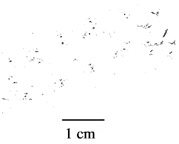Other Animal Tracks
(click on photos to see a larger version)
Amphibians
Frogs
There are several kinds of frogs that live all around you, so you might see their tracks if you are looking in the mud near where they live.
Frogs usually have small feet with five long toes. The second toe from the outside will probably be the longest. The tips of their toes might also be wider than the rest of the toe because they have toe pads. You also might see their two smaller front feet in front and in between the back feet. These smaller front feet only have four toes.
Frogs get from place to place by jumping, so their tracks will be in small groupings at regular intervals.
Aquatic Frogs
These photos show tracks from aquatic frogs. The toes are pointed and connected with skin (webbing). Their webbed feet, like those of ducks, help them to be strong swimmers.
Tree Frogs
This photo shows a tree frog track. The toes are lobed and there is less webbing between the toes. Tree frogs use their long, lobed toes to cling to surfaces, like tree trunks and the sides of buildings.
Toads
Toads make prints that are similar to those of frogs. Their feet are a little fatter, and they tend to drag their feet a lot more when they hop. Also, toads often walk with alternating footsteps when they are not running away from something.
Reptiles
Lizards
Lizards leave tracks that vary greatly in size depending on the lizard. They usually have five long toes, and may show claw marks. When they walk, they alternate their feet back and forth like humans. You also might see a line in between their tracks where their tails dragged on the ground.
Turtles
If you see turtle tracks, you might not see all of their five toes, but you will see the marks made by their large footpads. Their tracks look like circles with small dots around the front of them where the toes are. When turtles walk, they drag their feet a lot and kick up a lot of dirt behind them. You also might see a tail track in the middle of it all.
Snakes
Snakes also leave tracks. They don't look like other reptile tracks because snakes don't have any legs or feet! Snake tracks will just usually appear as squiggly lines in the dirt where certain parts of the line are more defined than others. This is because they use their muscular bodies to push off of the ground beneath them.
Invertebrates with Legs
Invertebrates are active almost everywhere and they leave many tracks, so it is likely that you will see them. However, it can be very hard to tell their tracks apart!
Insects
Almost all insect tracks will look like small trails of many tiny jumbled feet.
The photo to the left shows an insect track next to a mouse footprint. The sunflower seed is there to give you a sense for how small the tracks are.
Beetles
Beetle tracks are some of the most distinctive insect tracks you might find. Their large back feet make endless sideways tick marks as they waddle along. Almost all insect tracks will look like small trails of many tiny jumbled feet.
Centipedes and Millipedes
Centipedes and Millipedes leave two distinctive lines of many dots that are close together.
Legless Invertebrates
Other invertebrate tracks to look for are those of earthworms, snails, and slugs.
Earthworms
Earthworm tracks will probably look like nothing more than a line in the dirt. If you see these thin lines in any rich dirt, you can guess that an earthworm has probably been by. Another good place to look is in the mud of puddles as they dry up.




